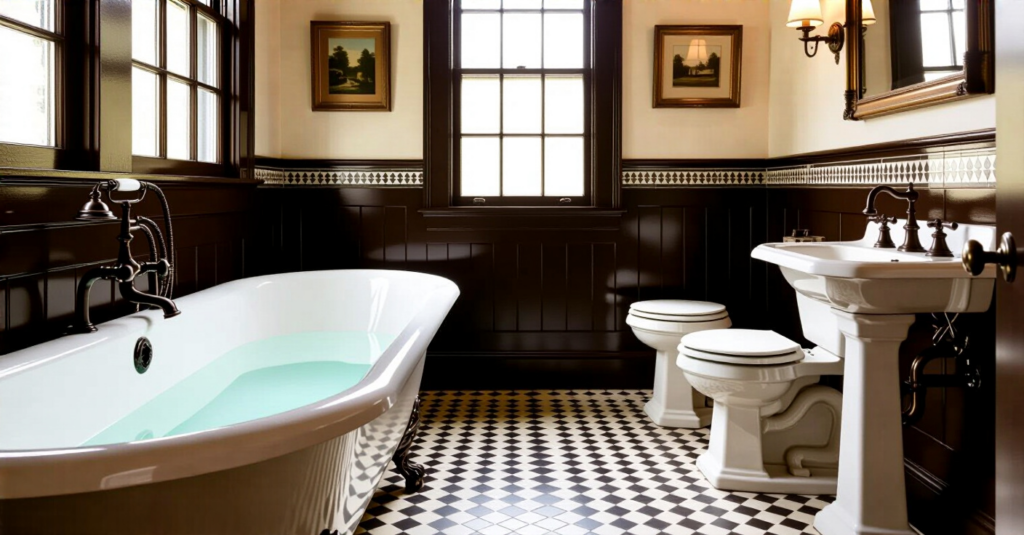Picture this: It’s the end of a long, stressful day. Your mind is still buzzing, your shoulders are tight. You close the bedroom door behind you and then open another door—not just to a bathroom, but to your personal retreat. The light is low and warm, the air smells faintly of lavender and eucalyptus, and the silence is a soft blanket. Every surface feels intentional and calming. This is the space where you wash away the day, not just physically, but mentally. It’s where your body gets the signal that it’s time to unwind, to soften, and to prepare for truly restorative sleep.
A traditional bathroom, when we approach it with intention, becomes so much more than a collection of vintage-style fixtures. It becomes a vital part of our nightly wellness ritual. Forget the sterile, cold bathrooms that feel purely functional. We’re going to talk about creating a room that feels like a deep, restorative breath. It’s about designing a sanctuary that calms your nervous system and helps you drift into the most peaceful state imaginable.
Laying the Traditional Foundation
Before we even think about a bathtub or a tile, we must lay the groundwork. This is the soul of the space. Think of it as creating the deep, steady rhythm that the rest of the room will follow. If we get this right, every other choice becomes easier and more intuitive, and the result is a room that feels deeply, authentically restful.
1. Identify Classic Design Eras for Authentic Style Inspiration
You know how people get overwhelmed trying to make things “historically accurate”? They start drowning in research about Victorian versus Edwardian details, and it all becomes homework. Here’s the secret: It’s not about passing a history exam. It’s about choosing a story. When all the elements in a room—the shapes, the materials, the lines—are telling the same gentle story, your brain can relax. There’s no visual static. It’s the visual equivalent of a soothing, melodic hum.
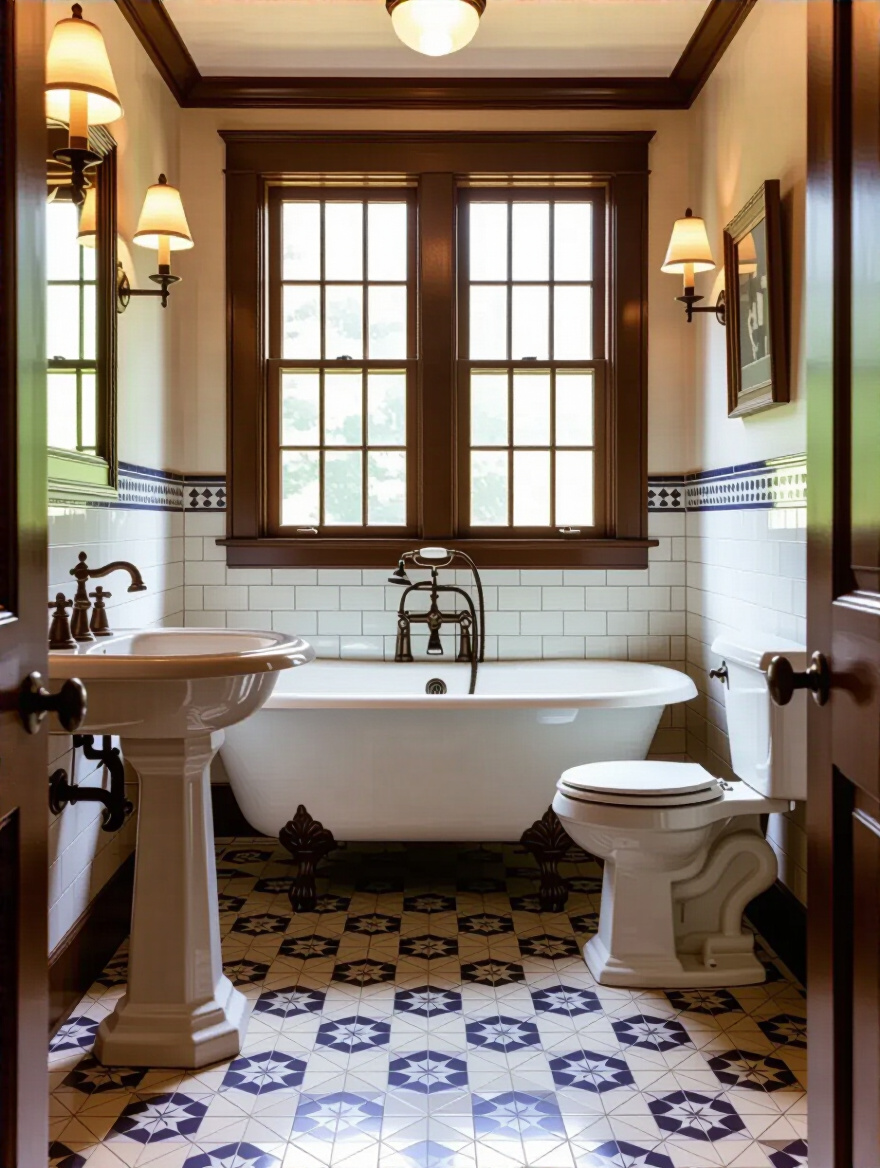 Clawfoot Tub and period fixtures” class=”wp-image-1856″/>
Clawfoot Tub and period fixtures” class=”wp-image-1856″/>Choosing an era like Arts & Crafts or Art Deco simply gives you a cohesive narrative to follow. It stops you from creating a space that feels visually jarring, which can subconsciously create a sense of unease. Think of it as choosing a single, peaceful melody for the room. A client of mine was renovating her 1920s home and was torn between so many styles. I encouraged her to simply lean into the Art Deco story her home was already telling. The result was a bathroom that felt like it had always been there, a seamless extension of her home’s calm spirit, which made her feel more grounded every time she stepped inside.
The true goal here isn’t rigid historical perfection. It’s about creating a harmonious visual language that allows your mind to quiet down and be present.
2. Select a Harmonious Traditional Color Palette for Serene Ambiance
Can we just talk about how everyone gets color wrong? They pick shades they think are “traditional” without understanding how those colors physically affect our bodies. Our nervous systems are profoundly influenced by color. Harsh, bright, or chaotic palettes can elevate our cortisol levels—the stress hormone—which is the absolute last thing you want in a sanctuary designed for winding down. The noise here is focusing on trends. The real story is in sleep science.
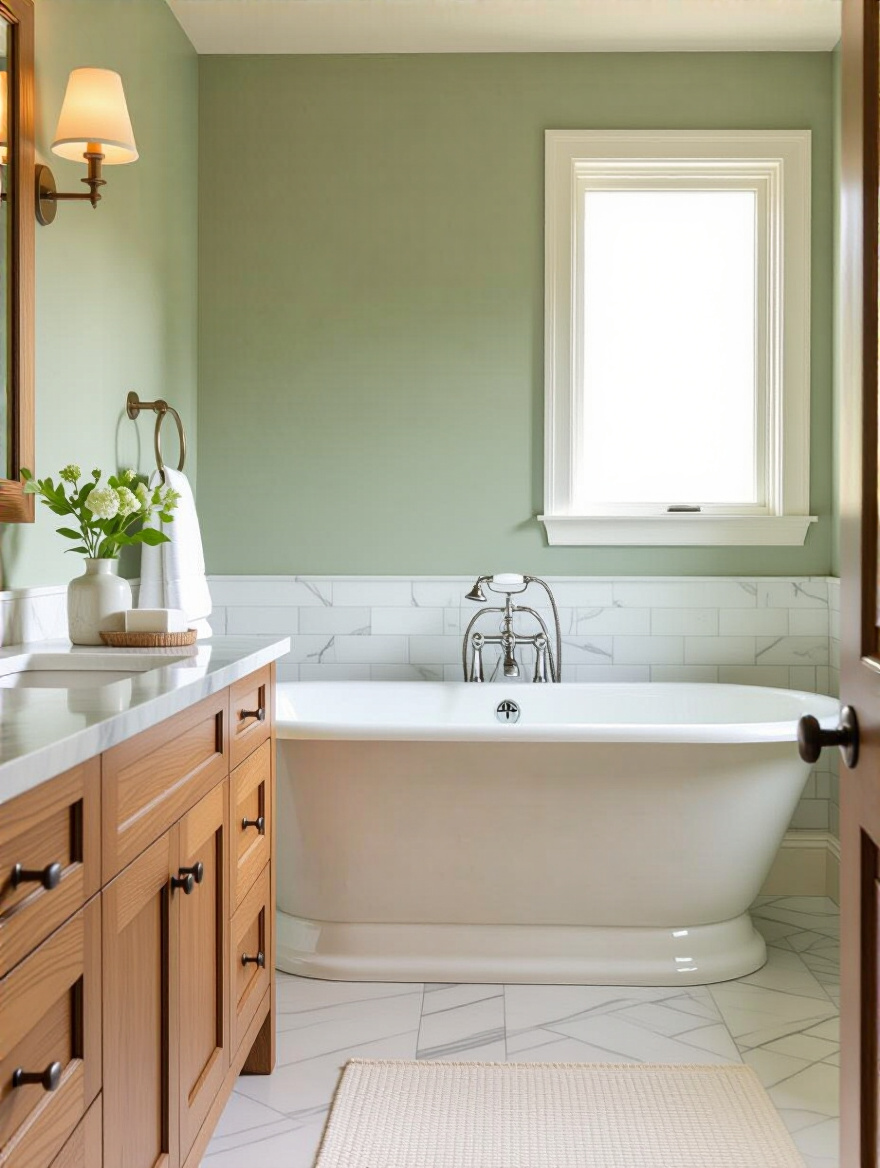
We want to surround ourselves with colors that mimic the natural world at its most tranquil. Think of the soft, dusky blues of a twilight sky, the warm cream of old parchment, the muted greens of moss after a rain, or the gentle grey of a misty morning. These are the colors that tell our bodies it’s safe to relax. A well-chosen palette isn’t a design choice; it’s a wellness tool. I always guide my clients to use the 60-30-10 rule: 60% a dominant, calming neutral; 30% a secondary, soft color; and 10% a gentle accent, perhaps through a warm metal or a single piece of art. This creates a balanced visual field that doesn’t overstimulate the brain, making it the perfect prelude to sleep.
The shortcut is to look at nature’s most restful moments. Find a photo of a serene landscape you love and pull your color palette directly from there. It will never fail you.
3. Determine Essential Layout Principles for Timeless Functionality
You might not think of a room’s layout as part of its “feel,” but a clumsy layout creates daily friction, and friction is a form of stress. If you’re constantly bumping your hip on the vanity corner or squeezing past the toilet to get to the shower, your body holds that tension. A truly serene space has a flow that feels as natural and easy as a slow-moving river. It’s about creating a choreography of calm.
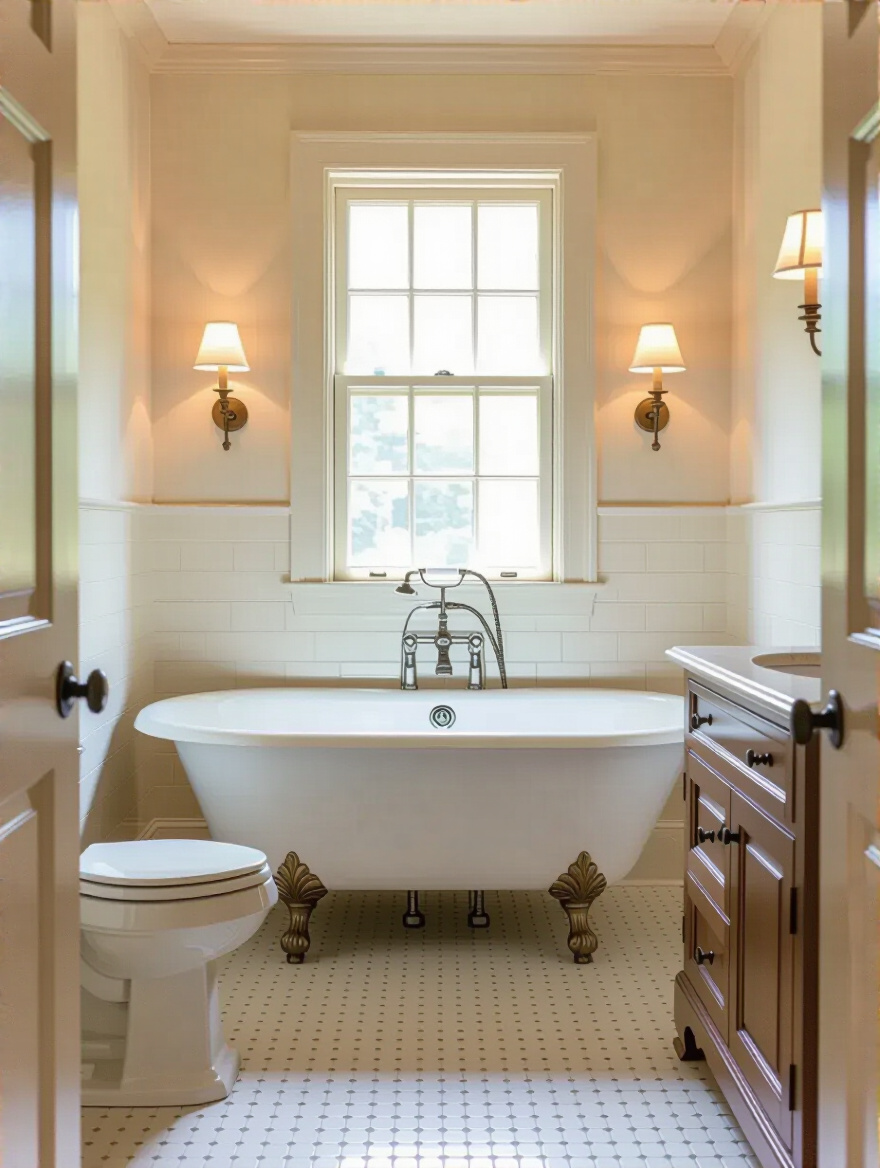
The goal is to create intuitive pathways and a sense of uncluttered openness, even in a small space. We want the toilet to be discreetly placed, not the first thing you see. We want ample, gracious space around the sink. And we want the path to the tub—your relaxation destination—to be clear and inviting. One of my clients had a beautiful but terribly designed bathroom. We used simple cardboard cutouts on the floor to mock up a new layout, moving the tub to be the focal point under the window. Just by “walking” through the mockup, she could literally feel her body relax. The new layout wasn’t just more functional; it was psychologically more peaceful.
Forget about cramming in every possible feature. The real luxury is space. Breathe. And move with ease.
4. Prioritize Investment Pieces for Enduring Traditional Charm
Everyone says to invest in the big-ticket items, but they rarely explain why from a wellness perspective. It’s not about resale value; it’s about your daily sensory experience. The things you touch and interact with every single day should feel good. Solid. Real. A cheap, hollow-feeling faucet handle or a flimsy acrylic tub sends a subtle message of disposability and impermanence to your subconscious.
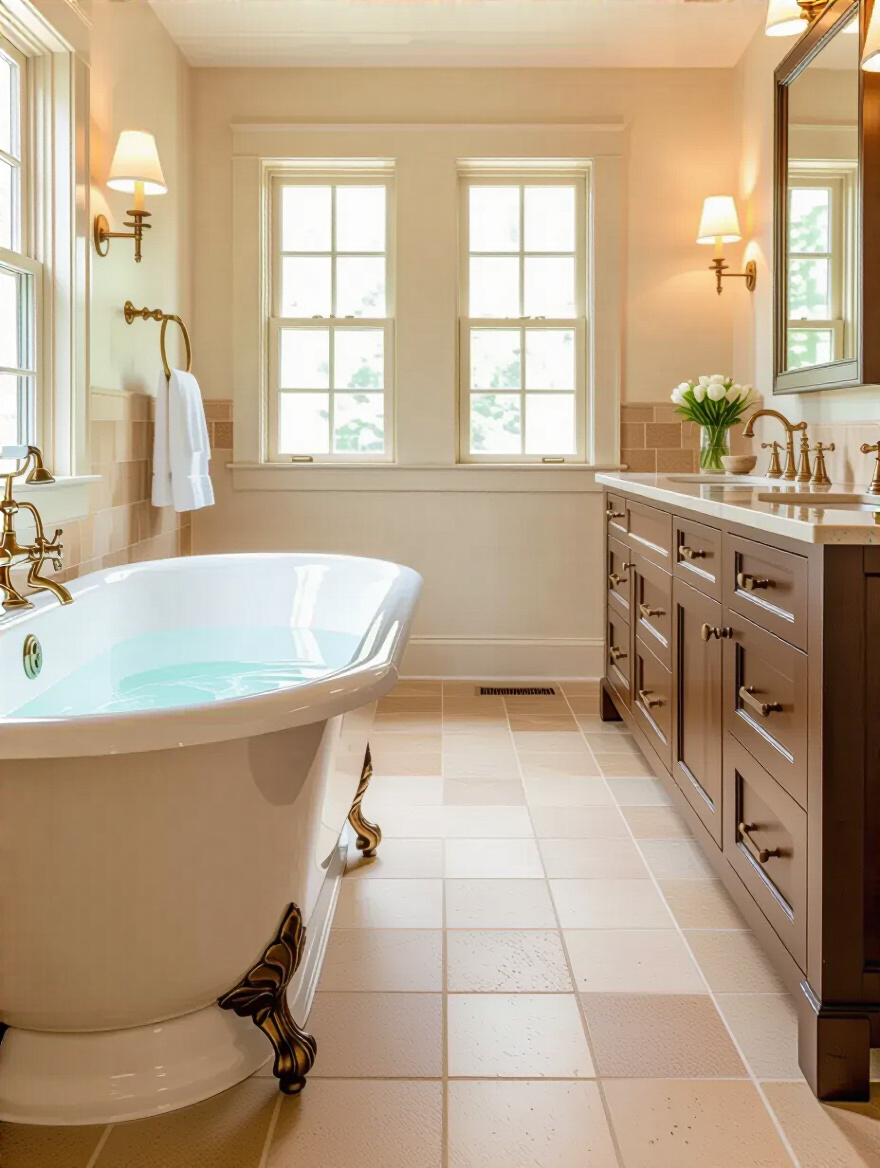
When you invest in a cast-iron tub, what you’re really investing in is superior heat retention, which means a longer, more deeply relaxing soak. When you choose solid brass taps, you’re investing in the satisfying, grounding weight you feel every time you turn on the water. These are the touchpoints of your sanctuary. They should feel substantial and nurturing. Focus your budget on the elements that you physically engage with: the tub, the vanity countertop, the fixtures. These are the pieces that will deliver a daily return on investment in the form of quiet, sensory pleasure.
Don’t skimp on the things your body will touch. It’s a shortcut to making the entire space feel more luxurious and restorative, even if other elements are more budget-friendly.
5. Balance Period Authenticity with Modern Comfort Needs Seamlessly
I used to think that creating a traditional sanctuary meant forgoing all modern comforts. No heated floors, no dimmable lights, no amazing water pressure. I was wrong. The art isn’t in avoiding modernity; it’s in making it whisper instead of shout. The goal is to integrate comforts that enhance relaxation without visually disrupting the calm, historical story of the room.
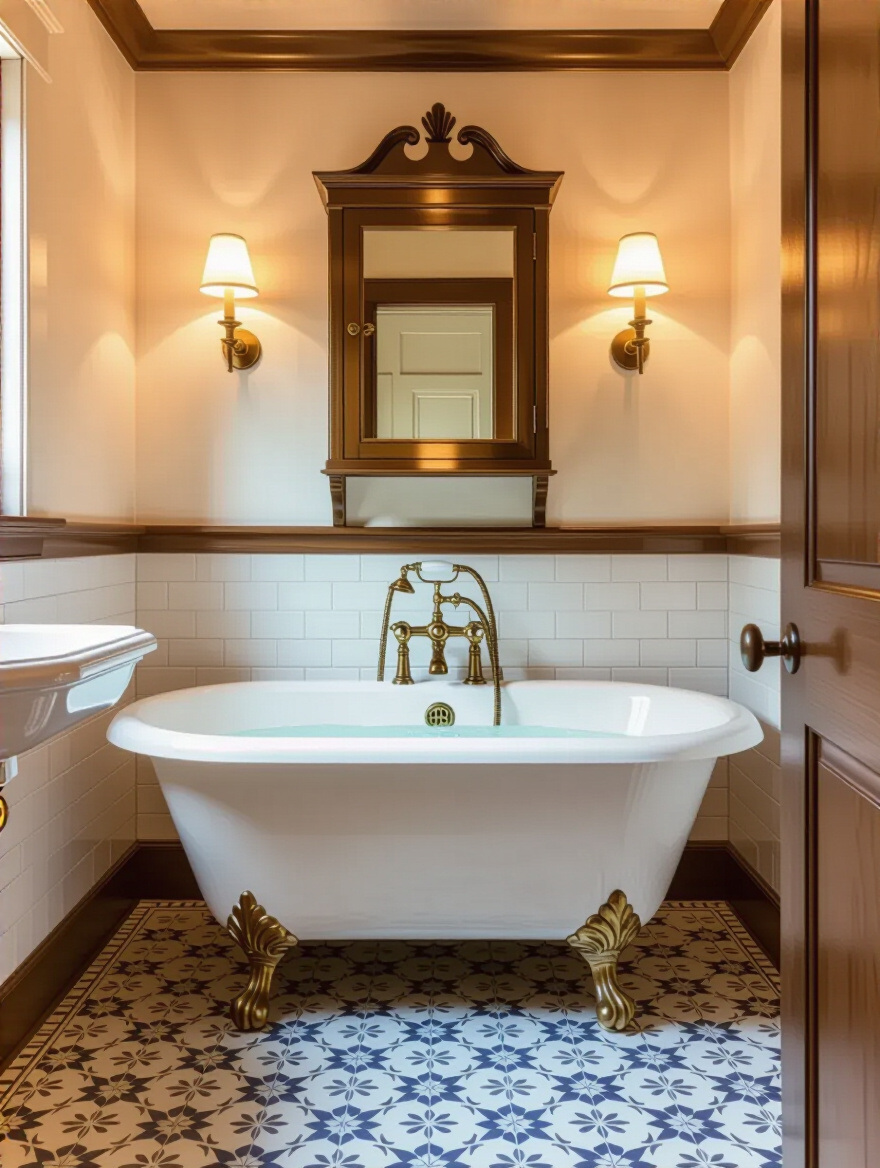
Think of it as invisible luxury. Radiant floor heating hidden beneath classic hexagonal tile, warming your bare feet on a cold morning. A state-of-the-art digital shower system controlled by valves that have a classic, traditional look. A vintage-style medicine cabinet that has a de-fogging mirror and a hidden electrical outlet inside for your water flosser. These are the details that make a space truly livable and luxurious without sacrificing its soul. You are blending the best of both worlds—the psychological comfort of a timeless aesthetic with the physical comfort of modern technology.
The secret is to let the traditional aesthetic be the star, while modern amenities play a quiet, supporting role.
Mastering Essential Fixtures & Hard Finishes
Once the calm foundation is set, we can begin to place the beautiful anchors of the room. These are the sculptural, functional pieces that define the space. Each one should be chosen not just for its look, but for the feeling it evokes and the role it plays in your daily ritual of renewal.
6. Choose Iconic Pedestal or Console Sinks for Elegant Period Appeal
A bulky, oversized vanity can feel heavy and oppressive in a bathroom, taking up both physical and visual space. A pedestal or console sink does the opposite. By lifting the visual weight off the floor, it creates an immediate sense of airiness and space. It lets the room breathe. This is especially vital in smaller bathrooms, where creating an illusion of openness is key to feeling serene rather than cramped.
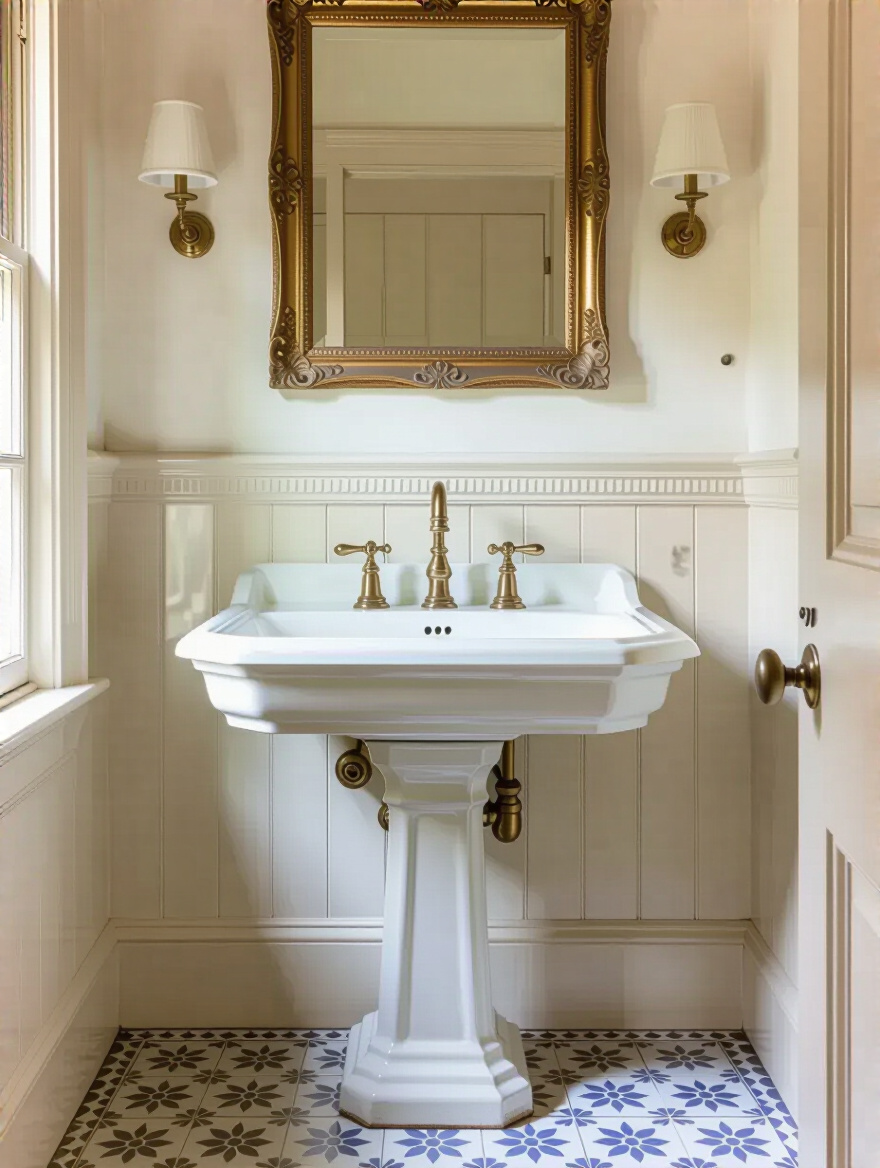
Yes, people panic about the lack of storage. “But where will I put all my stuff?” they ask. And that’s the point. It encourages a more mindful, curated approach. Instead of a deep cabinet where half-used bottles go to die, you are prompted to use beautiful, intentional storage solutions, like a small antique cabinet on the wall or a lovely woven basket on the floor. It gently forces you to declutter, and a clutter-free environment is essential for a clutter-free mind.
A pedestal sink isn’t a lack of storage; it’s an invitation to be more intentional about what you keep in your sanctuary.
7. Opt for High-Tank or Low-Level Toilets to Enhance Vintage Aesthetics
Let’s be honest, it’s hard to make a toilet feel soulful. But a high-tank or low-level toilet can do just that. It’s a sculptural piece that commits fully to the room’s historical narrative. The vertical lines of a high-tank toilet, with its elegant pull chain, draw the eye upward and add a touch of drama and grace, making the ceiling feel higher. It’s an unexpected touch of artistry in an otherwise utilitarian object.

More than just the look, choosing such a distinctive piece reinforces the idea that every element in your sanctuary matters. It signals that this is not a standard, builder-grade room, but a space that has been thoughtfully and lovingly curated. It’s a small detail that contributes to the overall feeling that you are somewhere special—a place set apart from the ordinary.
It’s one of the easiest ways to make a powerful statement that this room is dedicated to timeless beauty.
8. Select a Freestanding Clawfoot or Slipper Tub for Luxurious Focal Impact
A built-in tub/shower combo is functional. A freestanding tub is an invitation. It’s a sculptural work of art whose entire purpose is to cradle you for a long, deep soak. It’s designed for lingering. Its physical presence in the room signals that relaxation is not an afterthought here; it is the main event. This is the heart of your bathing sanctuary.
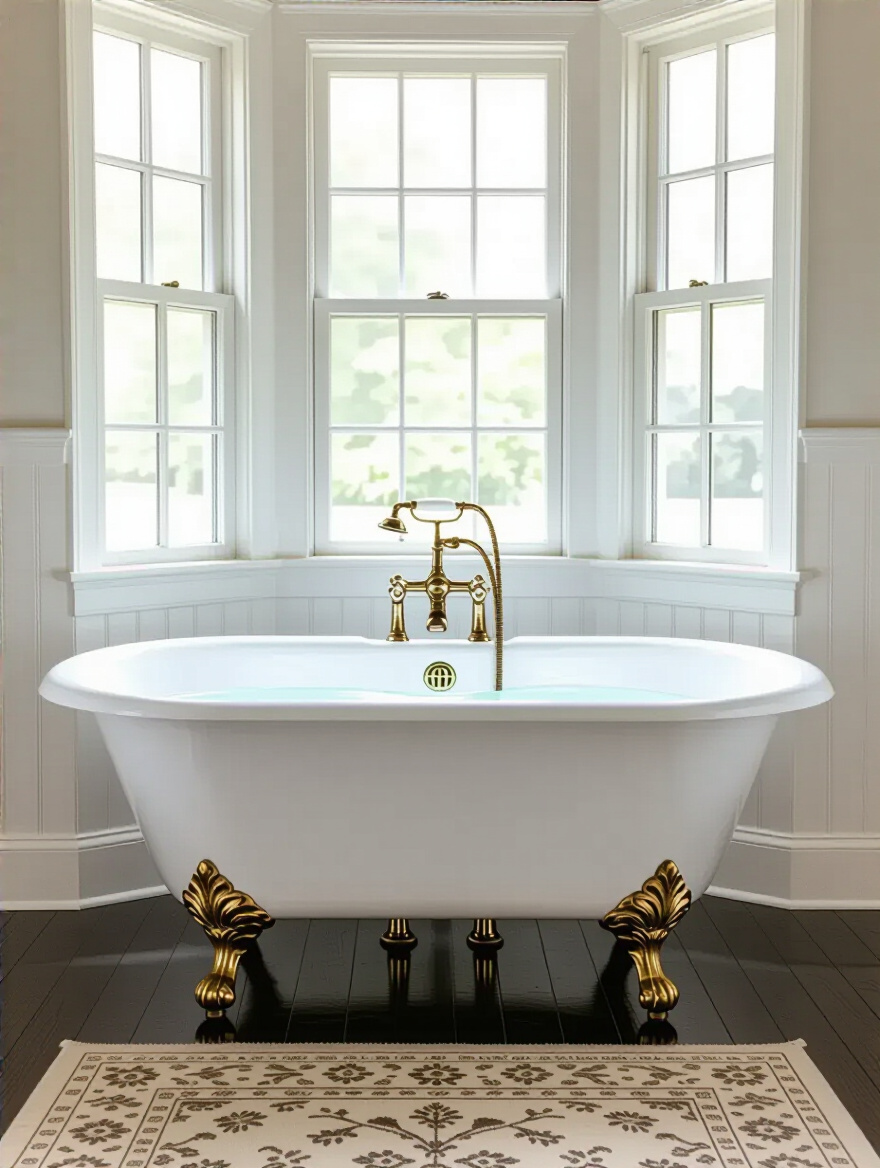
I learned this the hard way years ago, designing a bathroom for myself on a tight budget. I chose a standard alcove tub to save money and space. It was fine. It was functional. But it never once beckoned me to come and relax. I always regretted not finding a way to fit in even a small slipper tub. The shape of a freestanding tub—the way it curves to support your back, its generous depth—is engineered for surrender. It’s the single most important investment you can make in turning your bathroom into a true retreat.
When you see a clawfoot tub, your body instinctively knows what it’s for: letting go.
9. Install Traditional Style Taps and Shower Fixtures for Cohesive Beauty
The fixtures are the jewelry of the room. But more importantly, they are the primary touchpoints. Think about the heft and smooth rotation of a solid, cross-handle tap versus the flimsy lightness of a cheap one. That tactile feedback matters. It’s a small moment of sensory satisfaction that, repeated daily, contributes to a feeling of quality and calm.
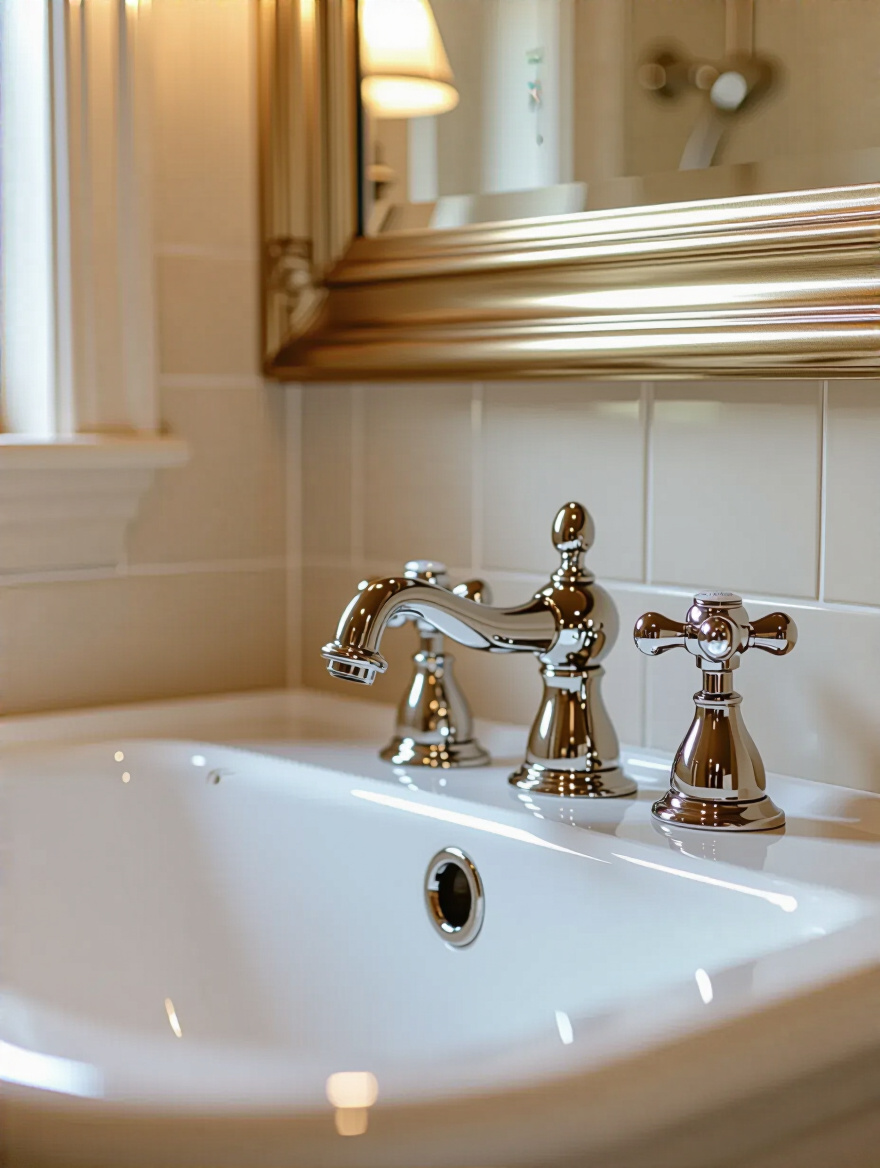
This is where you want to create a cohesive metal story. Choose one finish—like the warm, living patina of unlacquered brass or the soft, silvery glow of polished nickel—and carry it through the room. This consistency is calming to the eye. It helps all the elements speak to each other in a unified voice, reinforcing that cohesive story we talked about earlier. Don’t let these details be an afterthought; they are critical for tying the entire vision together.
When the things you touch every day feel good, the whole room feels better.
10. Employ Classic Marble, Subway, or Hex Tile for Enduring Wall Finishes
In a sanctuary, you want to quiet the visual noise. Busy, complicated patterns can be overstimulating for a mind you’re trying to calm. Classic tiles like subway, marble, or simple hexagon shapes offer a serene, orderly backdrop. Their beauty lies in their simplicity and their texture. The subtle veining in a slab of marble, the quiet rhythm of a subway tile wall, the honeycomb pattern of a hex tile floor—these are patterns that have endured because they are inherently pleasing and restful to the human eye.
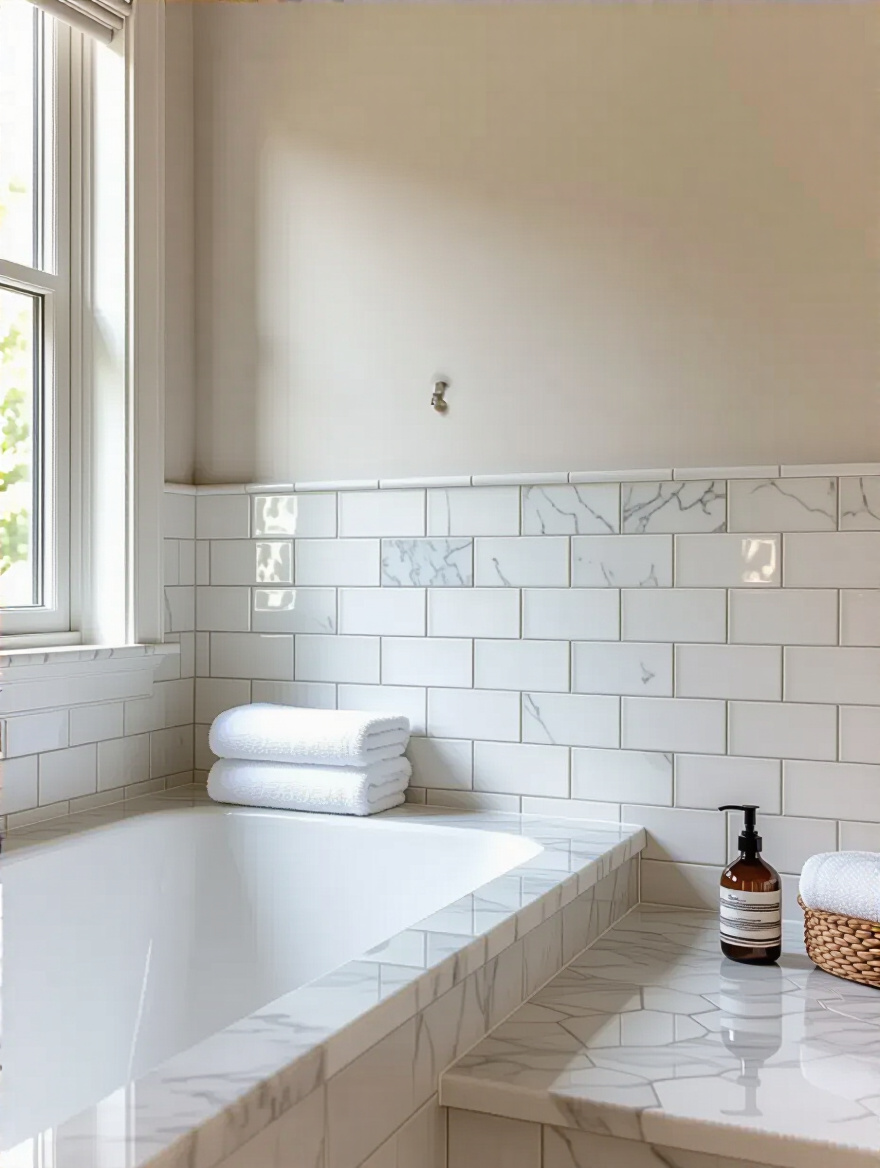
The trick is in the details. Use a grout color that provides a soft contrast, like a light grey with white subway tile, to gently define the pattern without being jarring. This approach gives you texture and interest without creating visual clutter. These materials also connect us to the natural world—stone from the earth, ceramic from clay—which has a grounding effect. I once worked on a bathroom where we used glossy, slightly imperfect subway tile. The way the low light reflected off the uneven surfaces created a watery, shimmering effect that was pure magic. It felt like being inside a seashell.
Choose surfaces that provide a quiet, calming rhythm for the eye to rest upon.
Curating Authentic Accessories & Soft Accents
The room has its bones. Now, we give it a soul. Accessories are where your personality and the deep feeling of comfort truly emerge. This is about layering in softness, light, and personal stories to make the space uniquely, restoratively yours.
11. Integrate Ornate Mirrors with Decorative Frames to Reflect Grandeur
A simple, frameless mirror is purely functional. An ornate mirror is an opportunity. It acts as a piece of art and a source of magic in the room. It doesn’t just reflect you; it reflects the soft light from a sconce, the steam rising from your bath, or a beautiful piece of art on the opposite wall. It bounces light and multiplies the beauty, making the room feel larger, brighter, and more enchanting.
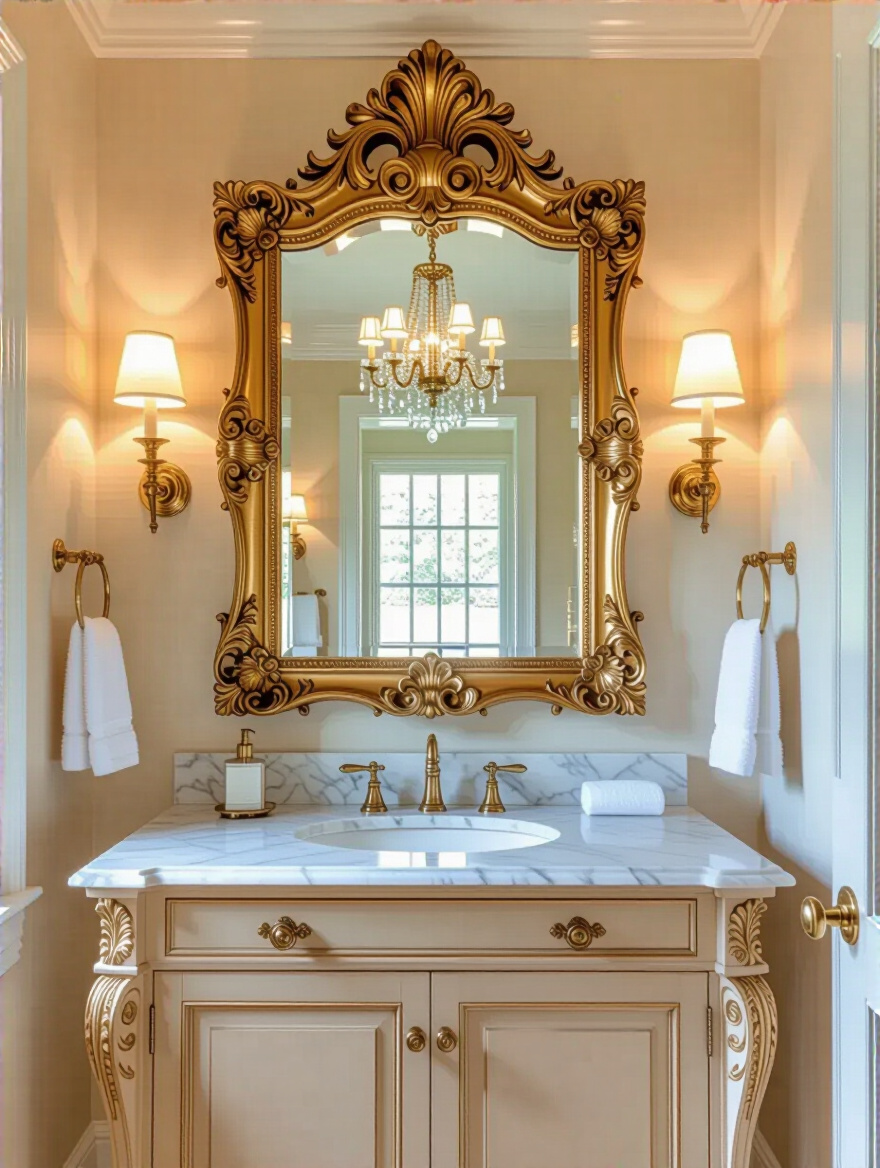
The frame you choose—whether it’s carved and gilded or simple and beaded—adds another layer to the room’s story. It’s a chance to introduce a shape that feels romantic or grand, adding to the sense of escapism. Position it thoughtfully. What do you want to see doubled? A beautiful view out the window? The flickering of a candle? The mirror is your tool to amplify the most serene elements of the space.
It’s less about seeing your reflection and more about reflecting the peace you’ve so carefully created.
12. Select Rich Wooden Vanity Furniture for Warmth and Functional Storage
In a room full of hard, cool surfaces like porcelain and tile, wood is an essential, grounding element. It brings the warmth of nature inside. The visual texture of a wood grain, the feel of a solid oak or cherry vanity—these things are inherently comforting and prevent a bathroom from feeling clinical or cold. It’s the visual equivalent of a warm hug.
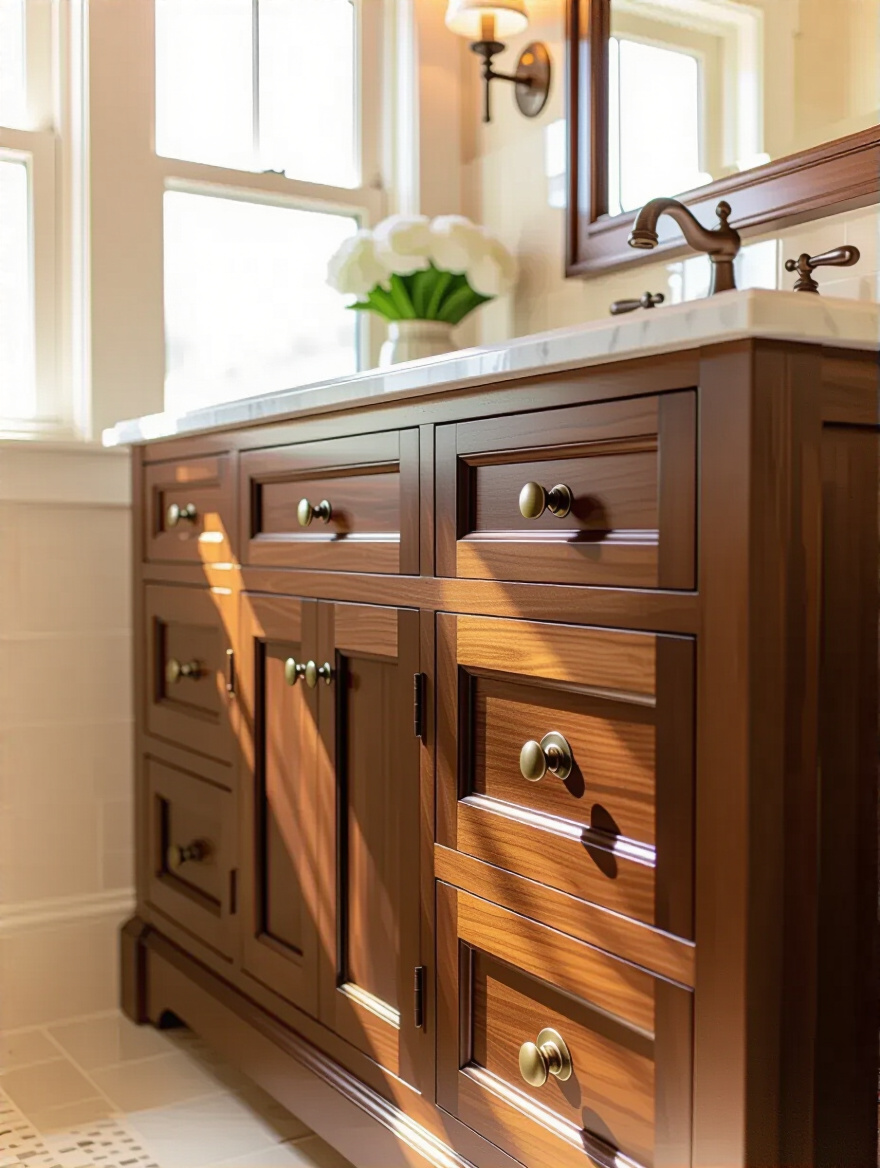
And this is where we call out the BS of cheap particle board. That stuff feels lifeless. It lacks the satisfying weight and integrity of real wood. A solid wood vanity isn’t just about durability; it’s about the feeling of substance it brings to the space. It becomes a beautiful piece of furniture that happens to be in your bathroom, offering you practical storage in a form that is deeply pleasing to the eye.
To create a sanctuary, you must invite nature in. Wood is one of the most powerful ways to do that.
13. Drape Plush Towels and Textiles for Luxurious Comfort and Texture
This is my pet peeve. People will spend a fortune on a marble countertop and then hang thin, scratchy, mismatched towels. It completely shatters the illusion of a sanctuary. Textiles are arguably the most important element for creating a feeling of luxurious comfort. Your skin is your largest organ, and the sensation of being wrapped in a thick, soft, absorbent towel after a warm bath is a profound part of the relaxation ritual.
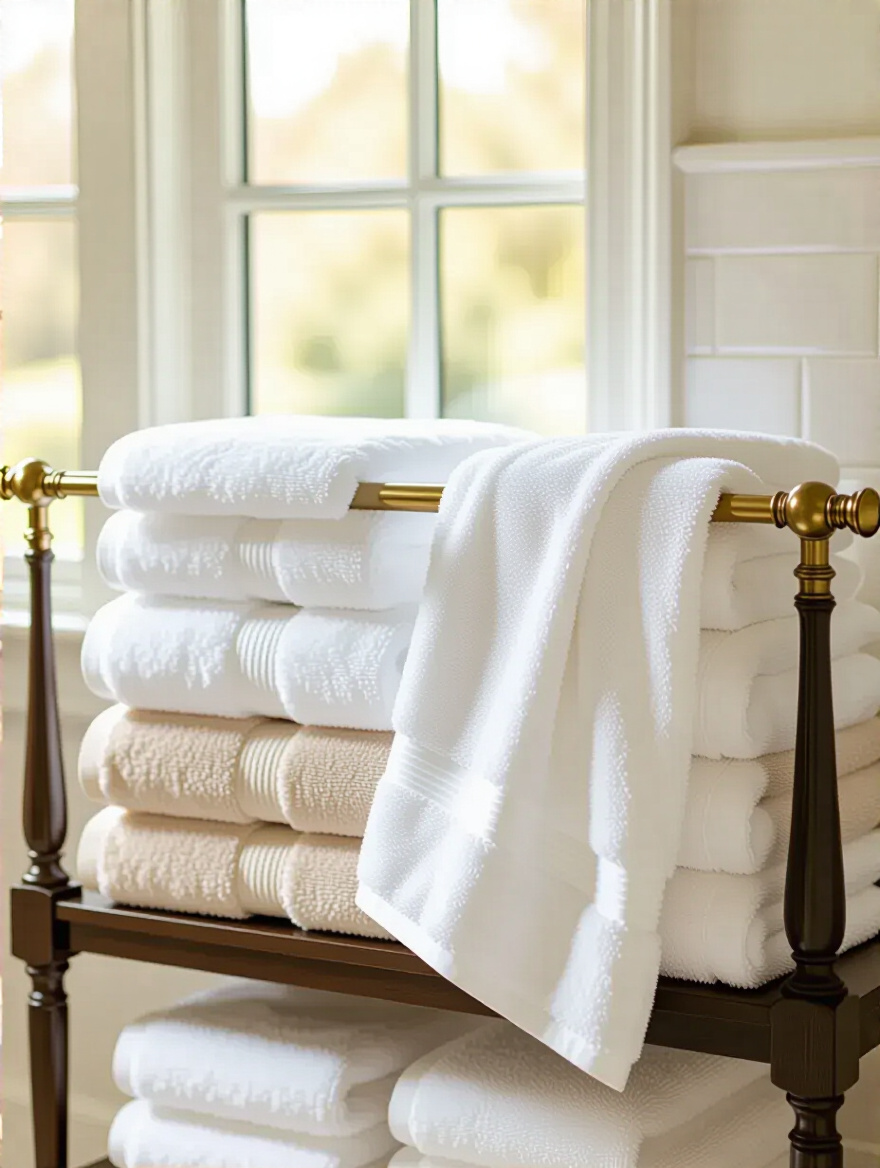
I’ll never forget staying at a supposedly five-star hotel where the design was stunning, but the towels felt like sandpaper. It was such a disconnect; my eyes were seeing luxury, but my body was feeling neglect. That’s when I realized: a great towel is not a splurge, it’s a non-negotiable. Invest in high-quality, 100% cotton towels with a high GSM (grams per square meter) of 600 or more. Choose a calming, cohesive color palette for them—crisp white, soft ivory, or a deep charcoal—and keep them beautifully folded or rolled. It signals an attention to detail that is, in itself, deeply calming.
Don’t just dry off. Wrap yourself in an embrace. It is the final, crucial step in your bathing ritual.
14. Arrange Vintage-Inspired Artwork or Botanical Prints for Personality
Your sanctuary should reflect you. But you don’t want to hang art that is energizing or thought-provoking. The art in this space should be serene and restful. Vintage botanical prints, soft landscape paintings, or simple architectural etchings are perfect choices. They add a layer of gentle interest and personality without demanding your mental energy.
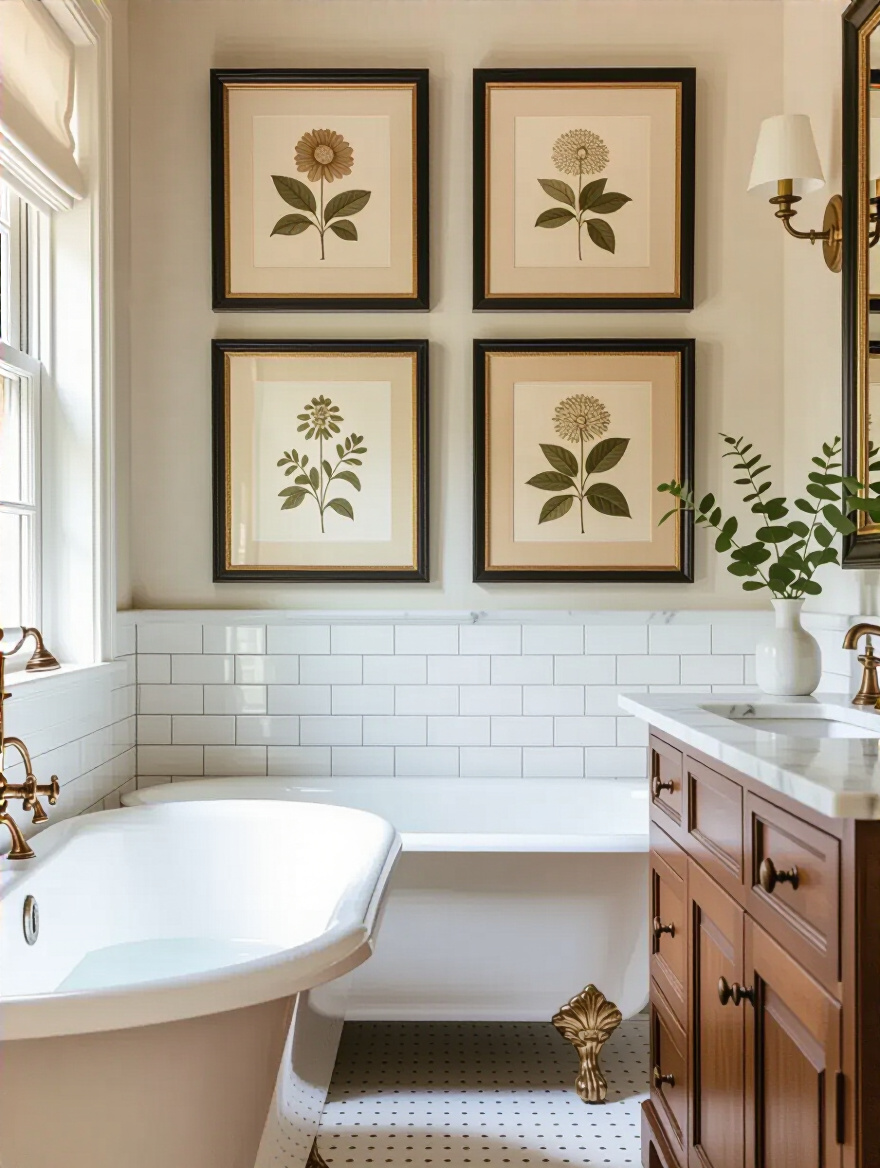
Protect your chosen pieces from humidity by using proper framing with sealed backs and acrylic instead of glass. Then, place them where they can be quietly enjoyed—perhaps a small collection of prints on the wall you face while soaking in the tub, or a single, calming landscape above the towel rack. It’s about creating small, beautiful moments for your eyes to land on as you move through your relaxation ritual.
The art here isn’t meant to be a statement to the world, but a quiet whisper to your soul.
15. Place Heirloom-Quality or Replica Accessories for Personal Character
This is what elevates a room from “well-designed” to “deeply personal.” A small silver dish inherited from your grandmother holding a bar of beautiful soap, a collection of old apothecary bottles on a shelf, a vintage crystal glass for your toothbrush. These objects are imbued with story and soul. They connect your personal history to your daily rituals, which is an incredibly grounding and comforting practice.

The key is curation, not clutter. Choose just a few items that have personal meaning or that perfectly fit the historical story of your room. An antique stool next to the tub is not just a place to set your towel; it’s a piece of history that adds character and warmth. These are the touches that make the space feel as if it has evolved lovingly over time, rather than being decorated all at once from a catalog.
Your sanctuary should feel like it has been waiting just for you. These personal treasures make that happen.
Elevating with Timeless Architectural Details & Practicality
We’re in the final stretch. These last touches are what cement the feeling of an established, well-crafted sanctuary. They blend the grander architectural gestures with the deeply practical needs of the space, ensuring it is as functional as it is beautiful.
16. Design Warm Layered Lighting Schemes for Inviting Ambiance
If you take only one piece of advice from me, let it be this: install dimmers on everything. A single, harsh overhead light is the enemy of relaxation. It’s jarring to the nervous system and disastrous for our natural circadian rhythm, telling our brain to be “on” when we’re trying to wind down. A layered lighting scheme is essential for creating a true sanctuary.
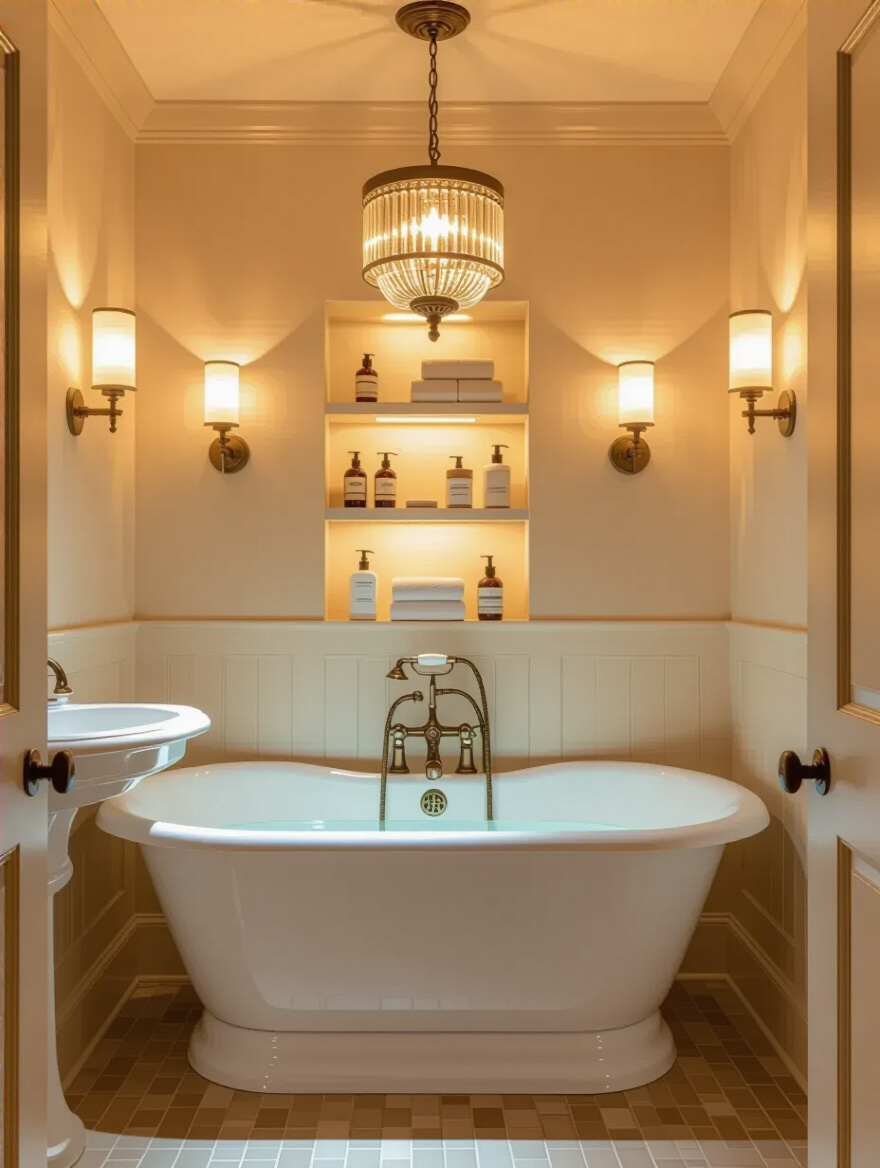
You need three layers. Ambient: a soft, general glow from a central fixture, like a small chandelier. Task: clear, shadow-free light at the mirror from sconces placed at eye level. Accent: a very low, warm glow from something like an LED strip under the vanity or a small lamp on a shelf. The most important part? All bulbs should be in the warm-white range (2700K) and every single circuit must be on a dimmer. This allows you to create a bright, functional space for getting ready in the morning and a low-lit, candle-like haven for your evening bath.
Your lighting should be a tool that helps you transition from the busy-ness of day to the restorative calm of night.
17. Incorporate Wainscoting or Beadboard Paneling for Architectural Interest
Wainscoting or beadboard does something wonderful for a room. It gives the space a feeling of being embraced. By adding a solid, textural element to the lower half of the walls, it grounds the room and adds a layer of architectural detail that feels classic and comforting. It’s a visual anchor that makes a room feel more substantial and finished.
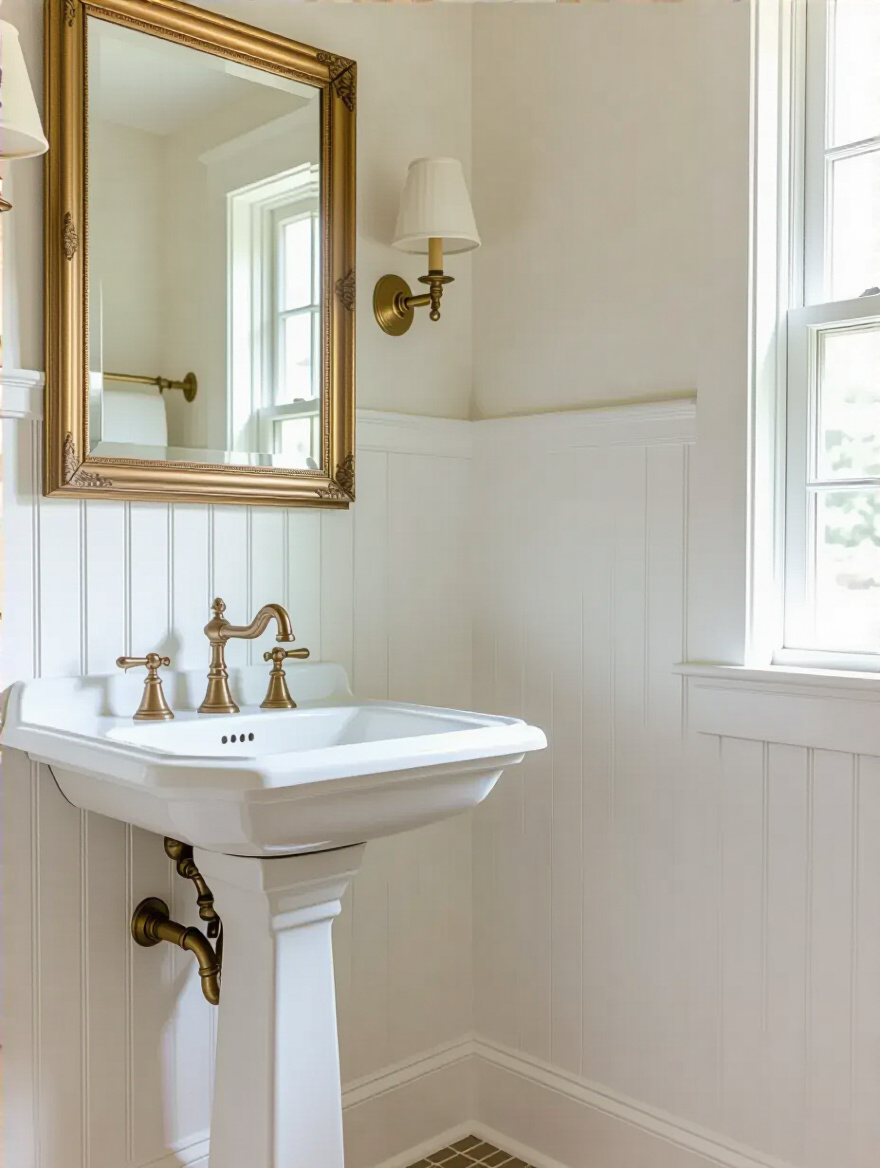
From a practical standpoint, it’s brilliant. It protects the walls from splashes and bumps, making the room more durable. But the psychological effect is more important. The clean, repeating lines of beadboard or the stately presence of paneled wainscoting adds a layer of rhythm and order that is deeply calming to the eye. It breaks up a plain wall and gives the space a timeless, reassuring character.
It’s like adding a foundational piece of furniture that is built right into the walls.
18. Choose Period-Appropriate Flooring like Penny Tiles or Large-Format Checkers
The floor is your physical foundation in the room. You want it to feel solid and authentic underfoot. Classic choices like small penny or hex tiles, or a simple black-and-white checkerboard pattern, instantly ground the room in a timeless aesthetic. The small scale of mosaic tiles provides a wonderful texture and excellent slip resistance, especially when wet.

But here’s the shortcut to ultimate sanctuary status: install radiant floor heating underneath your tile. There is almost nothing more luxurious and soothing than stepping out of a warm bath onto a floor that is also warm. It’s a touch of modern comfort that is completely invisible but transforms the entire experience of the space, especially in colder climates. It takes the room from beautiful to truly nurturing.
Your feet are incredibly sensitive. A warm, beautiful floor is a gift of comfort you give yourself every single day.
19. Utilize Decorative Storage Solutions for Clutter-Free Elegance
Visual clutter equals mental clutter. A countertop strewn with bottles, tubes, and devices creates a low-grade hum of chaos that undermines the peaceful atmosphere you’re trying to create. The solution is not to just hide things away in plastic bins, but to make your storage part of the beauty of the room. A well-designed traditional bathroom is a curated space.
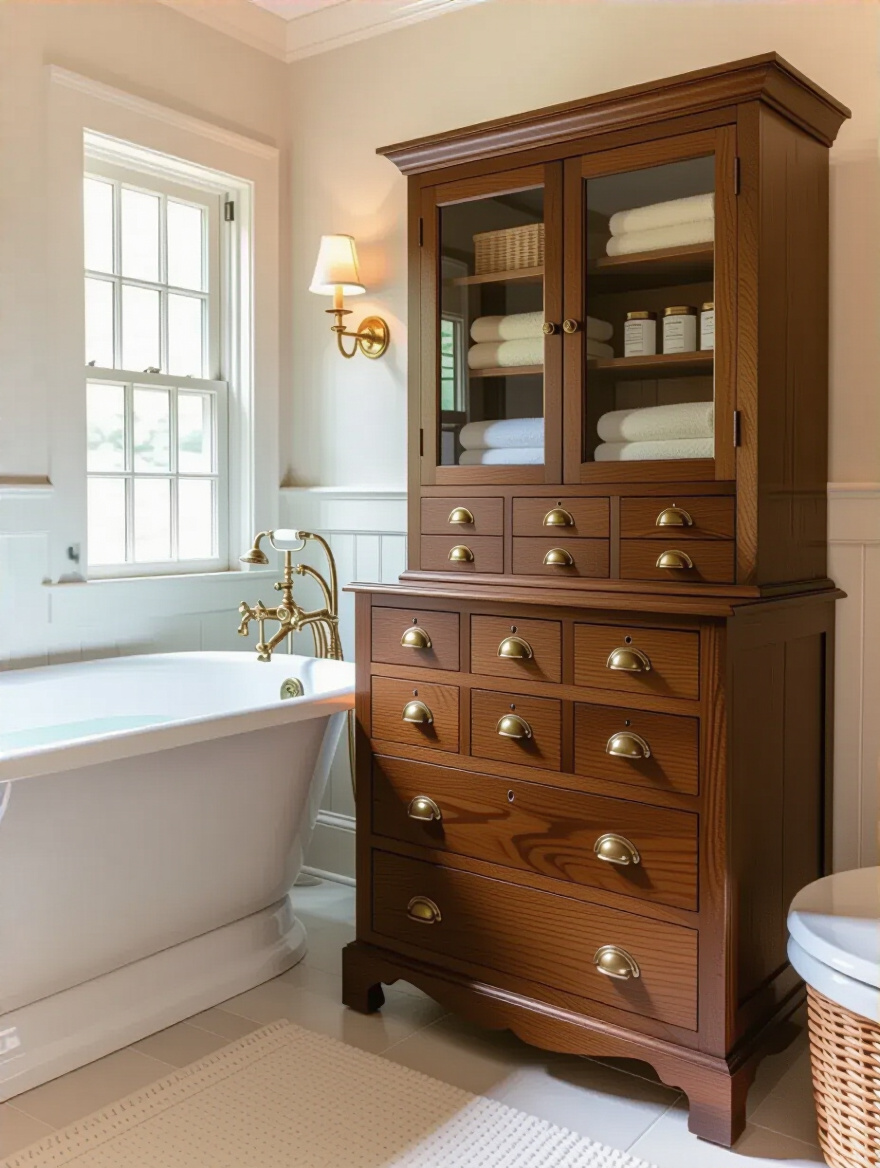
Think of elegant solutions that add to the decor. A freestanding glass-fronted cabinet to display neatly folded towels and a few beautiful objects. A set of vintage apothecary jars for cotton balls and bath salts. A beautiful antique tray to corral a few daily-use items on the vanity. The goal is for everything your eye sees to be either beautiful or useful—and ideally, both.
By making your storage beautiful, you ensure that every corner of your sanctuary contributes to a feeling of organized, elegant calm.
Conclusion
Crafting a traditional bathroom is a journey back to a place of quiet intention. It’s a conscious decision to create a space that nurtures you, that calms you, and that serves as a beautiful bookend to your day. This is about more than just aesthetics; it’s about weaving together color, light, texture, and story to create a physical environment that prompts a psychological and physiological state of deep relaxation. This is your personal sanctuary, a place dedicated to the art of unwinding.
By embracing these principles, you are not just renovating a bathroom; you are making a profound investment in your own well-being and your quality of sleep. You are creating a daily ritual of peace. Now, the power to create this for yourself is in your hands.
Take the first step today: Choose just one idea from this guide—perhaps the plush towels, the dimmable lighting, or a single piece of calming art—and think about how you can bring that one small element of sanctuary into your life. Imagine the peace that awaits.
